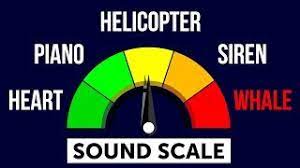What Is The Quietest Sound We Can Hear?
Perhaps you are a sensitive sleeper and noisy neighbors interrupt your sweet night’s sleep. Have you ever wondered what range of sound waves the human ear can hear and what is the quietest sound it can pick up? To learn more, keep reading!

What Is a Decibel?
A decibel (dB) is a unit that measures the strength of sound. The decibel was first used in acoustics by Fletcher and Munson in 1926. It is a logarithmic unit which is used to measure the ratio between the power of a sound and its intensity. For example, if someone talks loudly, it’s a 100 decibel noise.
Sound Frequency
The smallest sound in the human ear that you can detect is at 1 kHz, which can change from person to person. Sometimes this changes a little depending on what frequency your ears are used to hearing sounds at. The length of a pure tone- such as the tone of your voice, or in this case the vibration or pressure wave- is related to its frequency (Hz). In a sound wave, the distance between when the wave starts and ends is called its wavelength (m). The velocity of a sound is related to its frequency, as well as its intensity.
Sound Intensity
The quietest sound a person can hear is not always 0 dSPL. This absolute threshold of the human hearing range is an average — some people may hear much quieter sounds, while others may be harder of hearing. Plus, this 0 threshold only applies to tones measured at 1 kHz. This is problematic because our ability to hear doesn’t only derive from the intensity of the sound, but also with the sound’s frequency, or pitch. The intensity of a sound is the energy per square meter per second it produces, it is usually measured in decibels sound pressure level or dB SPL. Decibels are a comparison with a reference pressure level of 20 micro-pascals.
The amplitude of a sound is its height, or how loud it is. Intensity and amplitude are related by the basic equation:I = I0 × A, where I0 is the intensity of the sound and A is its amplitude. Human hearing becomes much less sensitive at frequencies below 1 kHz, making the sound pressure we can hear increase 1,000 times. However, for frequencies just above 1 kHz, our hearing threshold can be -9 dbSPL. This means that we hear noises as though they have a pressure level of 9 dBSPL. We can still hear the noise, but it is less intense.
Range Of Sounds That The Human Ear Can Hear
The loudness of sound waves measured in decibels (dB) relative to the average pressure for a given frequency. This can be approximated by looking at the RMS level and noting the distance between the mean level and the RMS level for given frequency. For example, if the RMS level is 500 and the mean is 1,000, then intensity is 27 dB. So the quietest sound a human can hear, while officially 0 decibels, is actually dependent on the sound’s pitch and the person’s ability to hear. The general range is from about 20-20,000 Hz. Though we’re capable of distinguishing between 1400-odd pitches, most of the important speech-related sounds fall within a narrow, relatively low spectrum. The threshold for humans seems to be around 16,000 Hz.
What Are the Quietest Natural Sounds We Can Hear?
| Sound | dB | Volume |
| Library, bird calls (44 dB); lowest limit of urban ambient sound | 40 | One-eighth as loud as 70 dB. |
| Quiet rural area. | 30 | One-sixteenth as loud as 70 dB. Very Quiet |
| Whisper, rustling leaves | 20 | Extremally Quiet |
| Breathing | 10 | Barely audible |
What Can You Hear In the World’s Quietest Room?
The anechoic chamber is known to have the lowest decibel levels in the world, and is estimated to be 9.4 decibels. This room is found in so many events across the world, where speakers are able to easily share their experiences with others through presentations and speeches. Not only are these speakers able to describe their feelings, but they can also hear the sound of their stomach, heart, and blood flow without any outside interference.